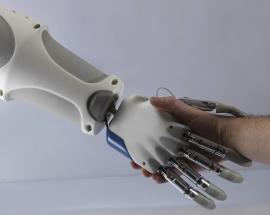Prostheses and their Types
PROSTHESES - special adaptations intended for use in cosmetic and functional compensation of the absent body parts. There are dentures upper and lower extremities, ocular prostheses and dental prostheses, prostheses for ear, nose.
Anatomical prosthesis, which is carried out to eliminate the cosmetic defect;
Atypical prosthetics is applied in cases where is not obviously possible to use the standard scheme;
Medical and hospital dentures are used for the preparation for prosthetics and training for use of the prosthesis;
Permanent dentures are divided into operational and functional and cosmetic - by form and function can be approximated to a normal limb. Working prostheses are designed to hold or use any tools, as well as for self-service.
Manufacturing of Prostheses
Modern medical industry has progressed far enough in the direction of the prosthesis, which allows to produce high-quality dentures for people of different ages and with varying degrees of motor activity: for the elderly, for people with active lifestyles, athletes, children, etc.
Dentures are made to orthopedic factories or workshops. For sophisticated prosthetics, as well as training in the use prostheses, near a number of factories are the hospitals. Prostheses can be made of leather with metal bus bars, of wood, metal; plastics.
When building a lower-limb prostheses are taken into account the general laws of physiology of man's standing and walking, and individual characteristics amputated. To provide cushioning shocks, occurring when walking, and fluency of gait, in the prosthetic foot are used microporous rubber.
The Use of Prostheses
By the time of Prosthetics, the portion of the limb that remains after amputation, must to have a healed the wound, be a movable in the joints and painless. The skin of the amputation - to be healthy and without folds, scars - moveable, not soldered to the bone. The prosthesis according to its shape, size and appearance, should be light, durable, conform to healthy body parts, user-friendly and hygienic.
To ensure the functionality of the absent limb, it should allow mobility in locations corresponding to the joints healthy limb, providing natural and confident movements while sitting, during stance and work, not to cause pain, to be well secured to the stump, not to cause abrasions of the stump. Prostheses for the lower extremities should provide a natural, quiet, smooth, elastic gait.
All parts of the prosthesis must be replaced easily. Making the prosthesis occurs individually for each lost a limb according to the profession and to the size of the patient's of the stump. Correctly created prosthesis is an effective factor in the rehabilitation of the disabled, in addition, that it is to a certain extent replaces the lost limb and increases operability.
Can be make a prosthetic appliance almost any stump. From the patient require great persistence and the will as well as significant physical effort, unusual for a normal healthy person. The patient in preparation to prosthetics should deal by a bracing gymnastics.
While preparing of the stump of the lower limb to prosthetics, are appointed a temporary prosthesis, during this period is occurs also learning skills of standing and walking on prostheses. Temporary prosthesis should have all the structural features of permanent prostheses, quickly and easily fabricated and replaced. When using temporary prostheses are strengthened muscles, begins to form stump and develop skills walk on artificial limbs.
Caring for the Prostheses
In order to prosthesis could serve during longer time, is necessary to take care for it:
- Lubricate friction metal parts (hinges) with engine oil;
- In order to ventilate the prosthesis, it must be removed at night;
- In ensuring the purity of the prosthesis, on the stump must wear a cover;
- Is necessary to avoid falling into the water prosthesis;
- When a wet, you must wipe dry all metal parts and lubricate the hinges; dry it in a warm place;
- In case of breakage of the prosthesis in no case should not repair it yourself, and to address in a special prosthetic and orthopedic workshop or a prosthetic factory;
- Daily, after the removal of the prosthesis, wash of the stump with warm water or wiping cologne.
Failure to comply with or ignoring the rules of hygiene can lead to pustular skin diseases and serve as an obstacle for use of a prosthesis for an extended period of time.
hide
 Prosthetics - replace body parts which have been lost due to disease, injury, or birth defect on prostheses, artificial body parts.
Prosthetics - replace body parts which have been lost due to disease, injury, or birth defect on prostheses, artificial body parts. 






